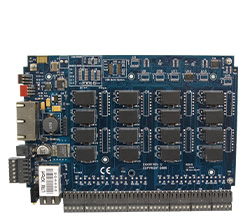Relays: Computer Driven Control Systems
 I’ve always had an interest in automation technology. One of the simplest and most useful components of computer driven control systems is an electrical relay.
I’ve always had an interest in automation technology. One of the simplest and most useful components of computer driven control systems is an electrical relay.
The most basic relays act as simple electrical switches. Various mechanisms (usually electromagnetism) are used to manipulate the switch, thereby allowing or preventing an electrical current to flow. The most exciting benefit of this component is that the controlling circuitry is isolated from the controlled circuit. The controller simply enables or disables power. This means that, depending on the relay’s construction, a very low-power controller like a simple microprocessor board can safely be used to manipulate the state of high-power devices such as motors, lighting, broadcast equipment, or just about anything else imaginable.
Relays can be constructed in various ways to allow unique operating characteristics. Some types of relays will add extra poles that can be used to switch power between two devices: Pump A to Pump B. Other relays add extra throws that allow multiple power sources to be controlled at the same time. Relays can be designed to control very high-power AC loads which can make their form factor very large, or they can be designed to switch low-power DC loads allowing them to be very small. Solid-state relays will retain their current state even if the controlling circuitry loses power.
When I first visited Sealevel, I was very interested in the PC peripherals being produced that made it very easy to interface with tons of relays. I knew right away that developing software to control these devices would be enjoyable. There is something magical about writing an application to turn on a device after a defined set of conditions and then seeing it happen. This kind of software doesn’t just display something on a computer screen; it directly affects the physical world. Working at Sealevel has provided me with a number of interesting projects that have relied on relay control. The most exciting projects I have worked on recently have been enabling device control from small form factor ARM based embedded devices.
If you didn’t know anything about relays, I hope this blog has given you a basic understanding of them. The next time you need to control an existing electrical device, you will know that you need a relay to do it, and you should have an idea of the type of relay you need.
Learn more about relays in Chapter 2 of Digital I/O Handbook" href="https://www.sealevel.com/support/the-digital-io-handbook/" target="_blank" rel="noopener noreferrer">The Digital I/O Handbook.
Categories:
